GPCR/G protein
G protein–coupled receptors (GPCRs) which are also known as seven-transmembrane domain receptors, 7TM receptors, heptahelical receptors, serpentine receptor, and G protein–linked receptors (GPLR), constitute a large protein family of receptors, that detect molecules outside the cell and activate internal signal transduction pathways and, ultimately, cellular responses. Coupling with G proteins, they are called seven-transmembrane receptors because they pass through the cell membrane seven times.
Products for GPCR/G protein
- GIP Receptor(2)
- FFAR1 (GPR40)(7)
- 5-HT Receptor(238)
- Urotensin-II Receptor(10)
- CCK2 Receptors(7)
- P2Y Receptor(25)
- EP4 Receptor(3)
- CRF1 Receptors(6)
- Melatonin Receptors(9)
- LPL Receptor(1)
- Adenosine Receptor(54)
- VIP Receptors(7)
- OX Receptor(15)
- Chemokine Receptors(16)
- Neurotensin Receptors(7)
- Prostanoid Receptors(21)
- CCK1 Receptors(5)
- Adrenergic Receptor(136)
- GPR119(5)
- Calcium-Sensing Receptor(3)
- Cannabinoid Receptor(36)
- Angiotensin Receptor(21)
- GPR120(2)
- Protease-Activated Receptors(9)
- PAF Receptors(3)
- Sigma Receptor(24)
- NK3 Receptor(6)
- NPY Receptors(23)
- Glucagon Receptor(16)
- Leukotriene Receptor(9)
- Bombesin Receptors(14)
- Sphingosine(14)
- CXCR(16)
- NOP Receptor(21)
- GPR55(5)
- Galanin Receptors(11)
- Endothelin Receptor(11)
- GPR35(7)
- Glucocorticoid Receptor(17)
- Calcitonin and Related Receptors(10)
- Bradykinin Receptors(12)
- mGluR(11)
- Adenosine Kinase(2)
- GPR109A(2)
- GPCR19(1)
- Non-selective CRF(7)
- LTD4 Receptor(1)
- Secretin Receptors(1)
- Melanocortin (MC) Receptors(16)
- ETB Receptors(5)
- NK2 Receptors(7)
- LPA Receptor(5)
- S1P receptor inhibitor(5)
- CCR2(5)
- Hydroxycarboxylic Acid Receptors(5)
- PACAP Receptors(3)
- Melanin-concentrating Hormone Receptors(7)
- Vasopressin Receptor(10)
- Somatostatin Receptor(15)
- TSH Receptor(1)
- Peptide Receptors(8)
- Ghrelin Receptors(9)
- ETA Receptors(3)
- Orphan 7-TM Receptors(6)
- Oxytocin Receptors(4)
- Ras(6)
- Heterotrimeric(1)
- CysLT1 receptor(1)
- Motilin Receptor(4)
- Acetylcholine(3)
- Prostaglandin Receptor(4)
- GHSR(4)
- EBI2/GPR183(1)
- Gonadotropin-Releasing Hormone Receptors(3)
- Orexin(3)
- Apelin Receptor(5)
- CRF2 Receptors(3)
- Calcimimetic Agent(2)
- Adrenergic Transporters(5)
- CaSR(3)
- EP1 Receptor(1)
- Sensory Neuron-Specific Receptors(1)
- 17,20-lyase(3)
- Adenosine Deaminase(3)
- NK Receptor(1)
- PGD2 Receptor(1)
- GLUT1(1)
- RGS(2)
- GPR44(1)
- Adiponectin Receptor(1)
- ERRγ(1)
- Cat.No. Product Name Information
-
BCC6049
Lys-γ3-MSH
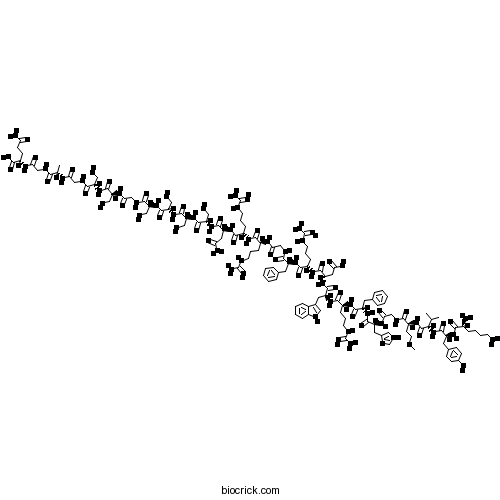
-
BCC7350
SNAP 5089

-
BCC4494
Bosentan Hydrate
Bosentan hydrate is a competitive and dual antagonist of endothelin-1 (ET) for the ETA and ETB receptors with Ki of 4.7 nM and 95 nM in human SMC, respectively.

-
BCC1898
Rimonabant hydrochloride
Rimonabant hHydrochloride (SR 141716A Hydrochloride) is a highly potent and selective central cannabinoid receptor (CB1) antagonist with an Ki of 1.8 nM. Rimonabant hHydrochloride (SR 141716A Hydrochloride) also inhibits Mycobacterial membrane protein Large 3 (MMPL3).

-
BCC7001
GR 159897
GR 159897 is a highly potent, selective, competitive, brain-penetrated non-peptide neurokinin 2 (NK2) receptor antagonist. GR 159897 has little or no affinity for NK1 and NK3 receptors. GR 159897 inhibits binding of [3H]GR100679 to human NK2 (hNK2)-CHO cells and rat colon membranes with pKis of 9.51 and 10, respectively. Antagonizes bronchoconstriction. Anxiolytic-like and anti-tumor effects.

-
BCC7085
GR 231118
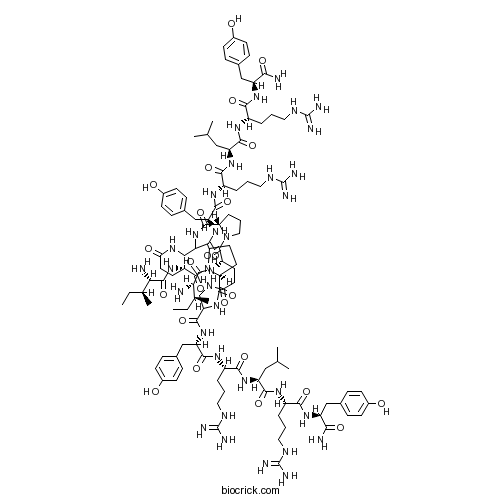
-
BCC7392
APC 366
Tryptase inhibitor

-
BCC7282
L-755,507
L755507 is a potent, selective agonist of β3-AR with an IC50 of 35 nM.
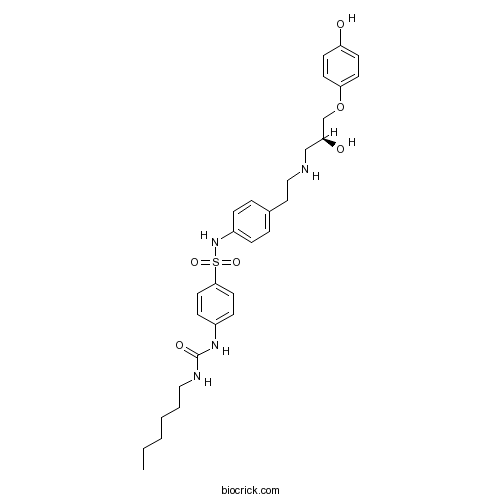
-
BCC7285
PNU 22394 hydrochloride

-
BCC6913
GR 55562 dihydrochloride
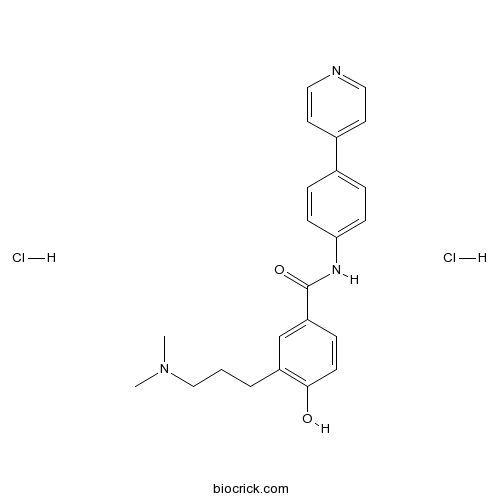
-
BCC1638
Ibutamoren Mesylate
Ibutamoren (Mesylate) is a potent, non-peptide Growth hormone secretagogue receptor (GHSR) agonist.

-
BCC8056
NIBR189
NIBR189 is a small molecule antagonist of the Epstein-Barr virus-induced gene 2 (EBI2; GPR183) receptor with IC50 of 16 nM(Binding) and 11 nM (Functional).

-
BCC7306
SCH 58261
SCH 58261 is a potent, selective and competitive antagonist of adenosine A2A receptor with an IC50 of 15 nM, and displays 323-, 53- and 100-fold more selective for A2A receptor than A1, A2B, and A3 receptors, respectively.
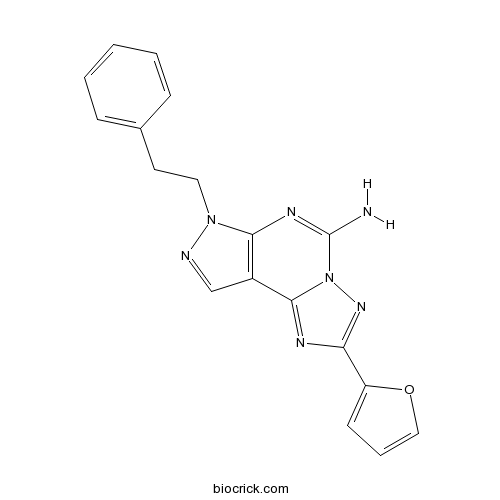
-
BCC5822
BIM 23127

-
BCC7438
L-368,899 hydrochloride
L-368,899 hydrochloride is a potent, selective, orally bioavailable, non-peptide oxytocin receptor antagonist, with IC50s of 8.9 nM and 26 nM for rat uterus and human uterus oxytocin receptor, respectively, used as a tocolytic agent.
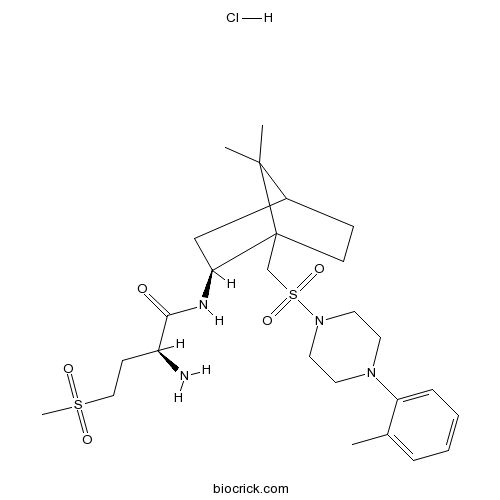
-
BCC6915
BW 723C86 hydrochloride
5-HT2B agonist

-
BCN2164
Silodosin
Silodosin (KAD 3213; KMD 3213) is a potent, selective and orally active α1A-adrenergic receptor (α1A-AR) blocker. Silodosin exhibits high affinity for α1A-AR (Ki=0.036 nM), over 162-fold and 50-fold than for α1B-AR and α1D-AR with Ki values of 21 nM and 2.0 nM, respectively. Silodosin is an effective and well-tolerated agent, it can be used for the investigation of LUTS/BPH.
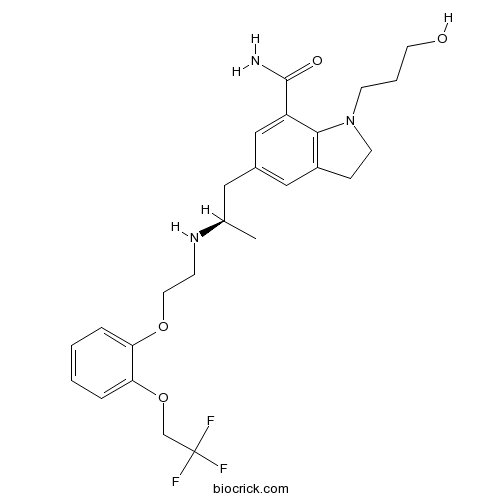
-
BCC6001
GLP-1 (9-36) amide

-
BCC7353
L-371,257
L-371,257 is an orally bioavailable, non-blood-brain barrier penetrant, selective and competitive antagonist of oxytocin receptor (pA2=8.4) with high affinity at both the oxytocin receptor (Ki=19 nM) and vasopressin V1a receptor (Ki=3.7 nM).

-
BCC7385
Melperone hydrochloride

-
BCC7523
CI 1020

-
BCN2167
Fingolimod hydrochloride
Fingolimod hydrochloride is a sphingosine 1-phosphate (S1P) antagonist with an IC50 of 0.033 nM in K562 and NK cells. Fingolimod hydrochloride also is a pak1 activator.
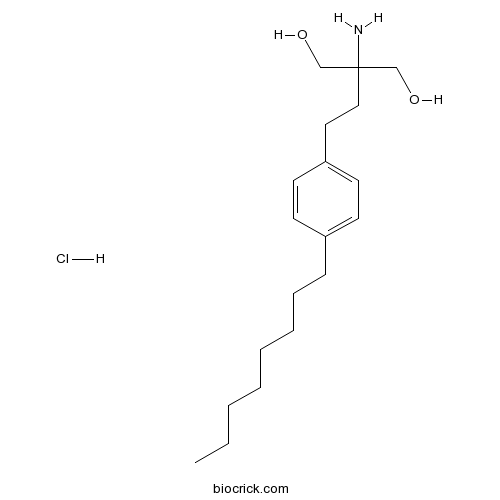
-
BCC5538
K-Ras G12C-IN-1
K-Ras G12C-IN-1 is a novel and irreversible inhibitor of mutant K-ras G12C extracted from patent WO 2014152588 A1.
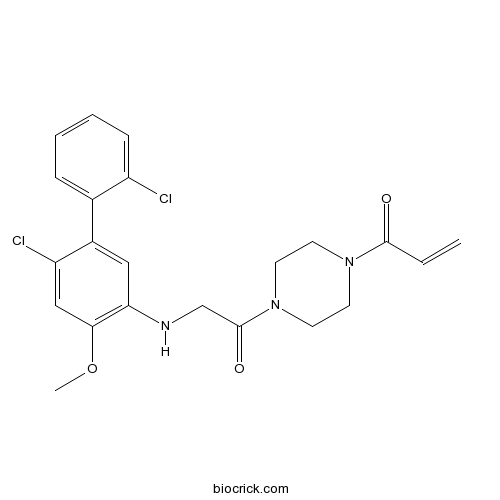
-
BCC5539
K-Ras G12C-IN-2
K-Ras G12C-IN-2 is an irreversible covalent K-Ras G12C inhibitor.

-
BCC5540
K-Ras G12C-IN-3
K-Ras G12C-IN-3 is a novel and irreversible inhibitor of mutant K-ras G12C.

-
BCC6938
2-Cl-IB-MECA
2-Cl-IB-MECA is a selective A3 adenosine receptor agonist (Ki = 0.33 nM). Displays 2500- and 1400-fold selectivity over A1 and A2A receptors respectively.

-
BCC6914
WIN 64338 hydrochloride
Bradykinin B2 antagonist

-
BCC1353
AM630
6-Iodopravadoline (AM630) is a selective CB2 antagonist with Ki of 31.2 nM, and displays 165-fold selectivity over CB1 receptors.

-
BCC6339
SA 4503 dihydrochloride
Cutamesine dihydrochloride (SA4503 dihydrochloride; AGY94806 dihydrochloride) is a potent Sigma 1 receptor agonist with an IC50 of 17.4 nM in guinea pig brain membranes.

-
BCC1525
Desmopressin
Synthetic vasopressin analog; V1B and V2 agonist,Desmopressin(DDAVP) is the synthetic analogue of the antidiuretic hormone arginine vasopressin.
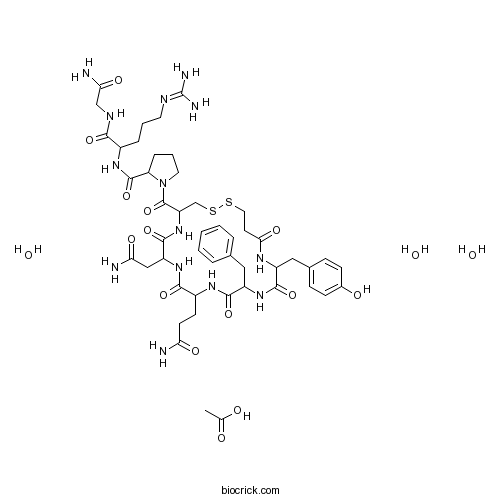
-
BCC7164
R-96544 hydrochloride
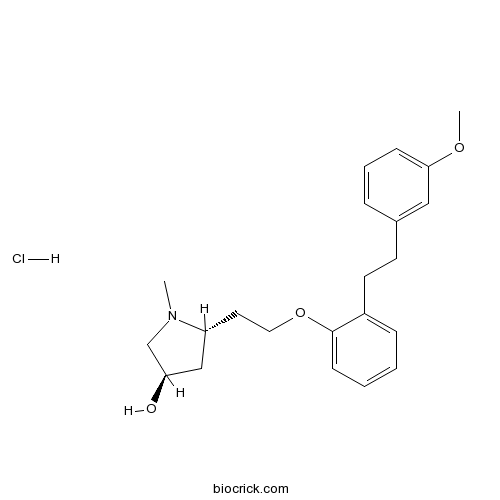
-
BCC5694
RS 39604 hydrochloride

-
BCC4414
Rimonabant
Rimonabant (SR141716) is a highly potent, brain penetrated and selective central cannabinoid receptor (CB1) antagonist with a Ki of 1.8 nM. Rimonabant (SR141716) also inhibits Mycobacterial
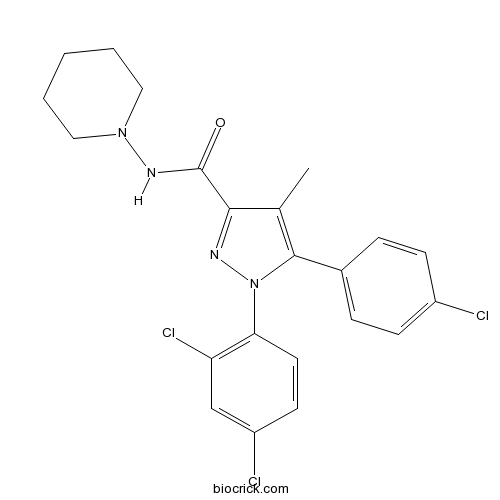
-
BCC6019
SHU 9119
SHU 9119 is a potent human melanocortin 3 and 4 receptors (MC3/4R) antagonist and a partial MC5R agonist; with IC50 values of 0.23, 0.06, and 0.09 nM for human MC3R, MC4R and MC5R, respectively.
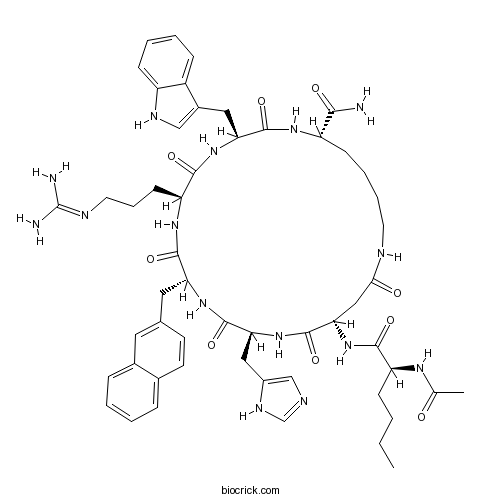
-
BCC3756
Conivaptan HCl
Conivaptan (hydrochloride) is a non-peptide antagonist of vasopressin receptor, with Ki values of 0.48 and 3.04 nM for rat liver V1A receptor and rat kidney V2 receptor respectively.

-
BCC5693
RS 67333 hydrochloride

-
BCC6878
RS 67506 hydrochloride
5-HT4 partial agonist

-
BCC6874
RS 17053 hydrochloride
RS 17053 hydrochloride is a potent and selective α1A adrenoceptor antagonist, with a pKi value of 9.1 in native cell membrane and a pA2 value of 9.8 in functional assays.

-
BCC7192
IRL-2500
IRL 2500 is a potent Endothelin receptor antagonist. IRL 2500 shows IC50 values of 1.3 and 94 nM for ETB and ETA receptors, respectively. IRL 2500 inhibits ETB receptor-mediated blood pressure increase and renal vascular resistance in rats in vivo.
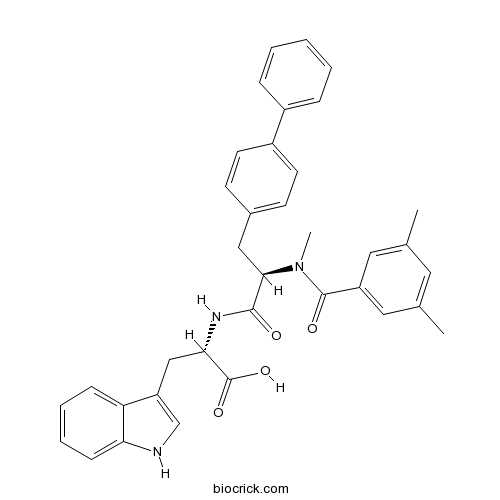
-
BCC7196
Ro 60-0175 fumarate

-
BCC5686
Nociceptin
Nociceptin, a heptadecapeptide, is the endogenous ligand of the nociceptin receptor, acting as a potent anti-analgesic.

-
BCC5790
Astressin
Astressin is a potent corticotropin releasing factor (CRF) antagonist.

-
BCC7742
Donitriptan hydrochloride
5-HT1B/1D agonist

-
BCC6697
N-Methylquipazine dimaleate
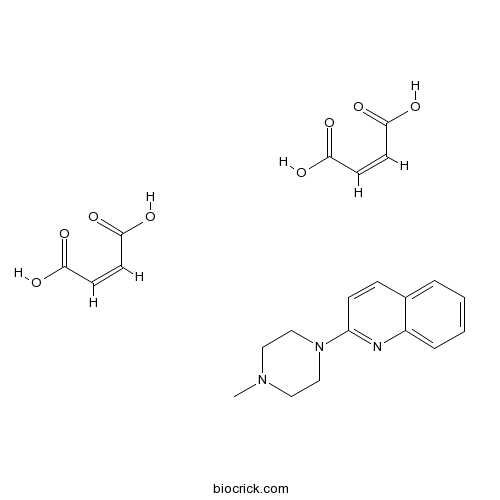
-
BCC5789
Urocortin (rat)
Urocortin, rat (Urocortin (Rattus norvegicus)) is a neuropeptide and a potent endogenous CRFR agonist with Kis of 13 nM, 1.5 nM, and 0.97 nM for human CRF1, rat CRF2α and mouse CRF2β, respectively.

-
BCC7558
LY 272015 hydrochloride

-
BCC7856
LY 266097 hydrochloride
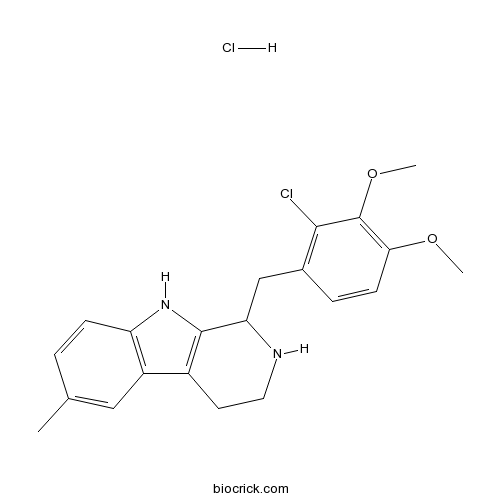
-
BCC7411
PB 28 dihydrochloride
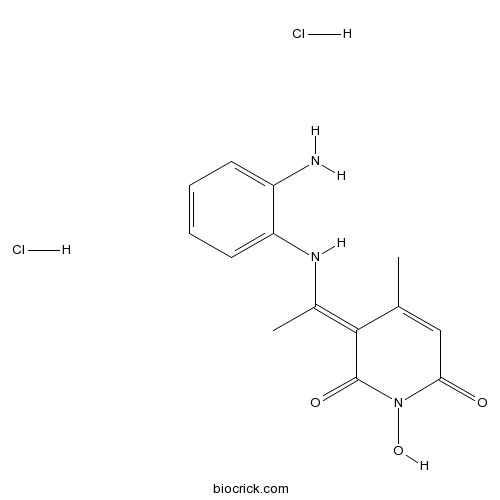
-
BCC5865
BWX 46
Highly selective NPY Y5 agonist

-
BCC7628
Rec 15/2615 dihydrochloride

-
BCC7650
BGC 20-761
High affinity 5-HT6 antagonist
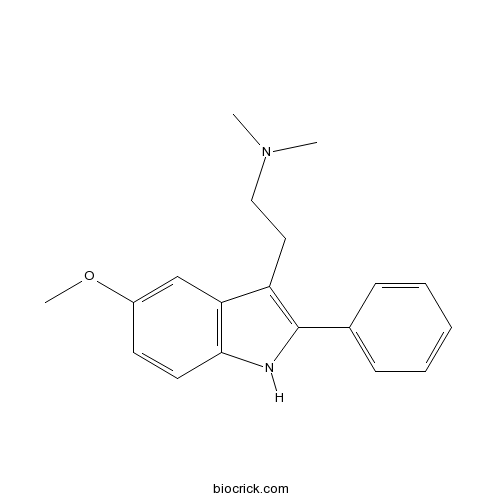
-
BCC7734
FR 171113

-
BCC1379
Atrasentan
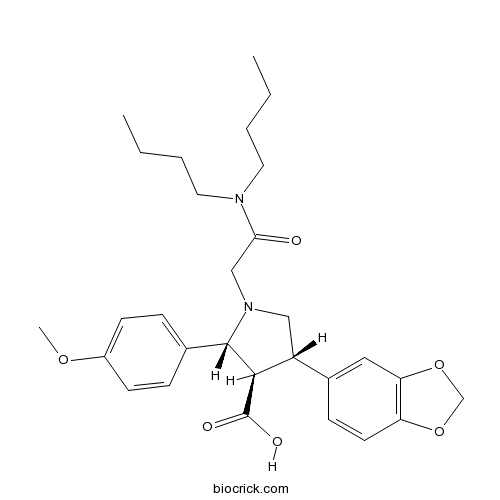
-
BCC1795
Nepicastat
Nepicastat (SYN117) is a selective, potent, and orally active inhibitor of dopamine-beta-hydroxylase. Nepicastat (SYN117) produces concentration-dependent inhibition of bovine (IC50=8.5 nM) and human (IC50=9 nM) dopamine-beta-hydroxylase. Nepicastat (SYN117) can cross the blood-brain barrier (BBB).

-
BCC7037
SB 218795

-
BCC1926
SB-222200
SB 222200 is a selective, reversible and competitive antagonist of human NK-3 receptor(Ki=4.4 nM) that effectively crosses the blood-brain barrier.
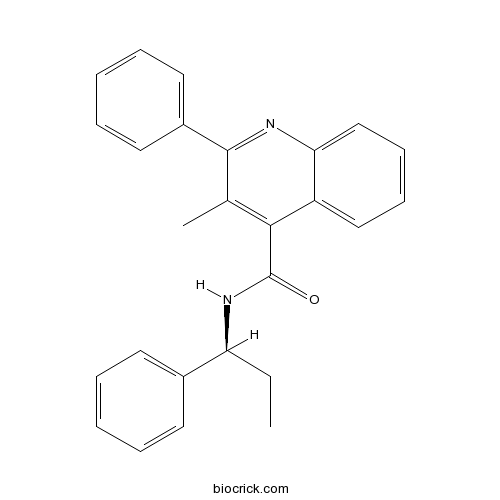
-
BCC1981
Talnetant
Talnetant (SB 223412) is a potent and selective NK3 receptor antagonist (ki=1.4 nM, hNK-3-CHO); 100-fold selective for the hNK-3 versus hNK-2 receptor, with no affinity for the hNK-1 at concentrations up to 100 uM.

-
BCC5913
CH 275

-
BCC5788
Urocortin (human)
Urocortin, human, a 40-aa neuropeptide, acts as a selective agonist of endogenous CRF2 receptor, with Kis of 0.4, 0.3, and 0.5 nM for hCRF1, rCRF2α and mCRF2β, respectively.

-
BCC6709
Metergoline
Metergoline is a psychoactive drug of the ergoline chemical class which acts as a ligand for various serotonin and dopamine receptors.

-
BCC7346
LY 320135

-
BCC7781
R 568 hydrochloride
Tecalcet Hydrochloride (R 568 Hydrochloride), an orally active calcimimetic compound, allosterically and positively modulates the calcium-sensing receptor (CaSR). Tecalcet Hydrochloride (R 568 Hydrochloride) increases the sensitivity to activation by extracellular Ca2+.

-
BCC5749
Nociceptin (1-13)NH2
Nociceptin (1-13), amide is a potent ORL1 (OP4) receptor agonist with a pEC50 of 7.9 for mouse vas deferens and a Ki of 0.75 nM for binding to rat forebrain membranes.
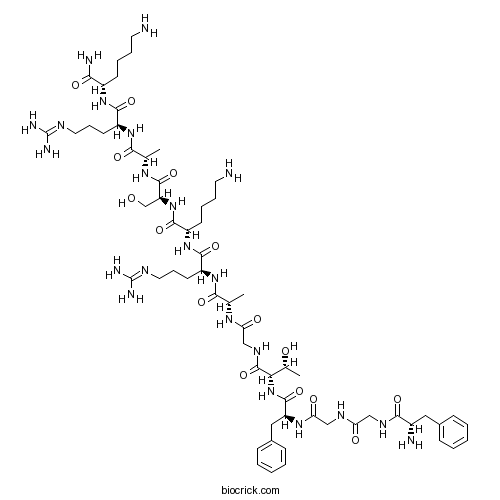
-
BCC6085
Orphanin FQ (1-11)

-
BCC5738
Nociceptin (1-7)

-
BCC5878
ZD 2079
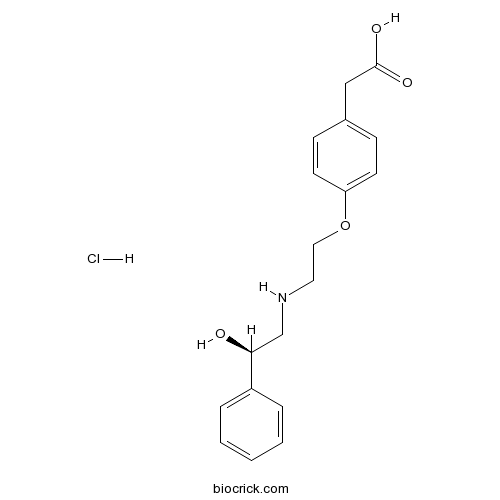
-
BCC7069
N-Arachidonylglycine

-
BCC6883
AH 11110 hydrochloride
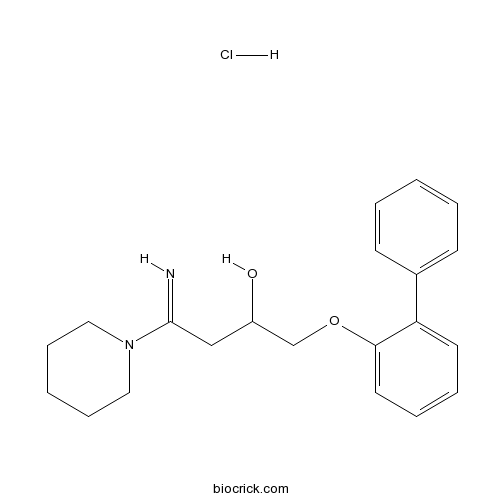
-
BCC6976
SB 224289 hydrochloride
SB-224289 hydrochloride is a selective 5-HT1B receptor antagonist, with anxiolytic effect.

-
BCC7284
PD 160170

-
BCC7036
SB 228357
SB228357 is a selective, potent oral active 5-HT2C/2B receptor antagonist with pKi values of 6.9, 8.0 and 9.0 for 5-HT2A, 5-HT2B and 5-HT2C, respectively. SB228357 has antidepressant/anxiolytic effects.

-
BCC4412
AM251
AM251 is a selective cannabinoid 1 (CB1) receptor antagonist with an IC50 of 8 nM, also acts as a potent GPR55 agonist with an EC50 of 39 nM.

-
BCC5823
CYN 154806
CYN 154806, a cyclic octapeptide, is a potent and selective somatostatin sst2 receptor antagonist, with pIC50 values of 8.58, 5.41, 6.07, 5.76 and 6.48 for human recombinant sst2, sst1, sst3, sst4 and sst5 receptors respectively.

-
BCC6972
MRS 1220

-
BCC1951
sitaxsentan
Sitaxsentan (IPI 1040; TBC-11251) is a selective endothelin A (ETA) receptor antagonist.

-
BCC7323
SR 142948

-
BCC6014
R 715
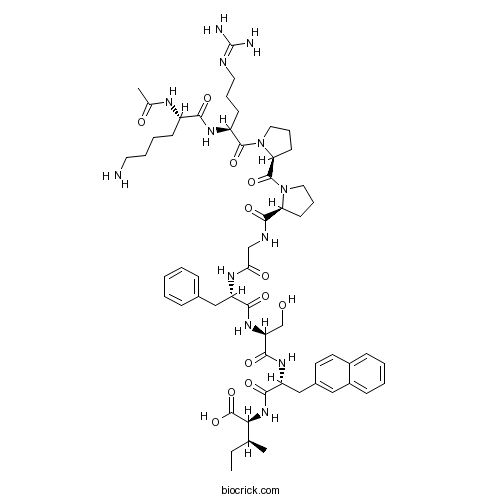
-
BCC5679
GR 46611
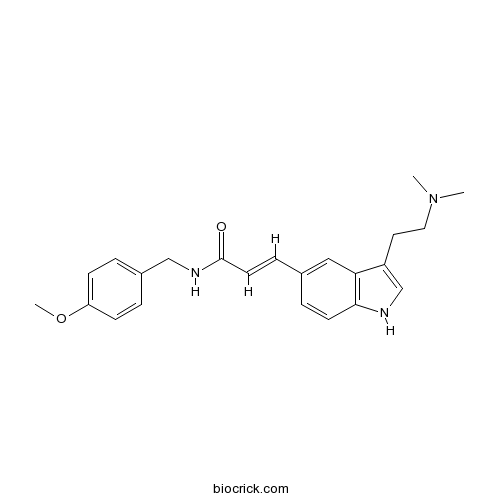
-
BCC5182
AMD 3465 hexahydrobromide
AMD 3465 hexahydrobromide (GENZ-644494 hexahydrobromide) is a potent antagonist of CXCR4, inhibits binding of 12G5 mAb and CXCL12AF647 to CXCR4, with IC50s of 0.75 nM and 18 nM in SupT1 cells; AMD 3465 also potently inhibits the replication of X4 HIV strains (IC50: 1-10 nM), but has no effect on CCR5-using (R5) viruses.

-
BCC5181
AMD 3465
AMD 3465 is a potent, selective CXCR4 antagonist, and inhibits SDF-1α-ligand binding with Ki of 41.7 nM.

-
BCC6876
RS 79948 hydrochloride

-
BCC2524
Zibotentan (ZD4054)
Zibotentan (ZD4054) is an orally administered, potent and specific ETA-receptor (endothelin A receptor) antagonist (IC50 = 21 nM).
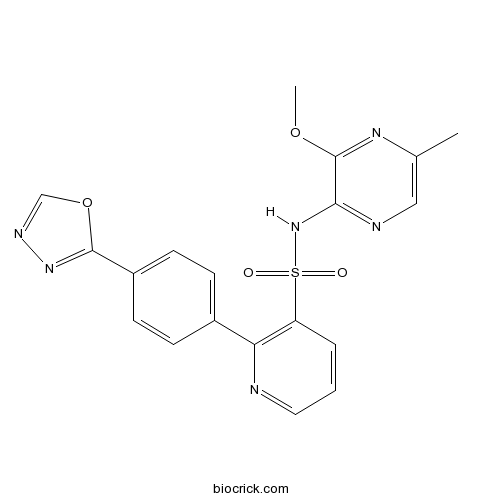
-
BCC7695
ML 10302 hydrochloride
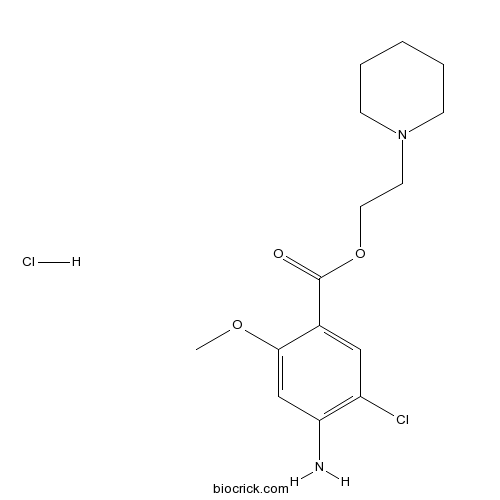
-
BCC7408
PNU 109291

-
BCC7222
PNU 142633
PNU-142633 is a high affinity, selective and orally active 5-HT1D receptor agonist with Kis of 6 nM and > 18 000 nM for human 5-HT1D receptor and human 5-HT1B receptor, respectively. PNU-142633 has anti-migraine efficacy.
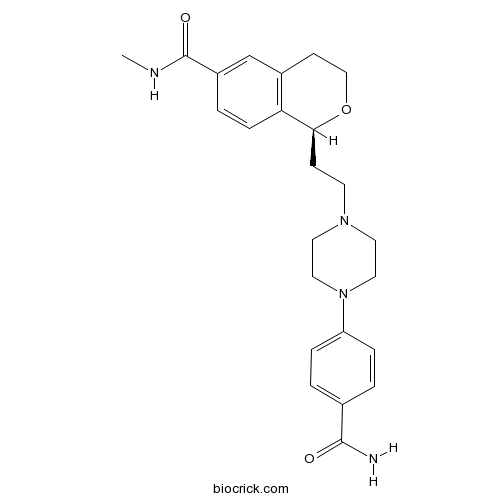
-
BCC7500
Arachidonyl serotonin

-
BCC5704
NocII

-
BCC7059
MAFP
MAFP (Methyl Arachidonyl Fluorophosphonate) is an selective, active-site directed and irreversible inhibitor of cPLA2 and iPLA2. MAFP is also a potent irreversible inhibitor of anandamide amidase.

-
BCC1919
Salmefamol
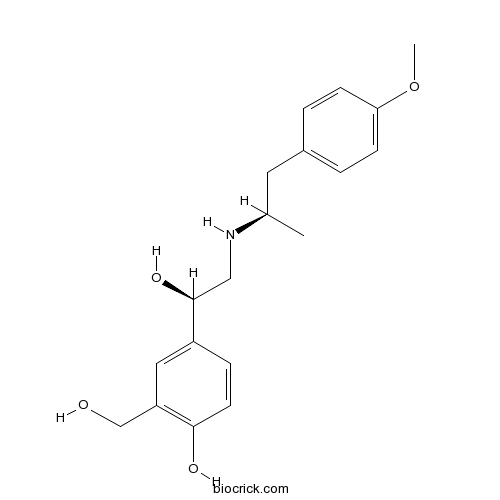
-
BCC7955
Tegaserod maleate
Tegaserod maleate is a partial agonist of the 5-HT4 receptor; stimulates the peristaltic reflex and accelerates gastrointestinal transit.
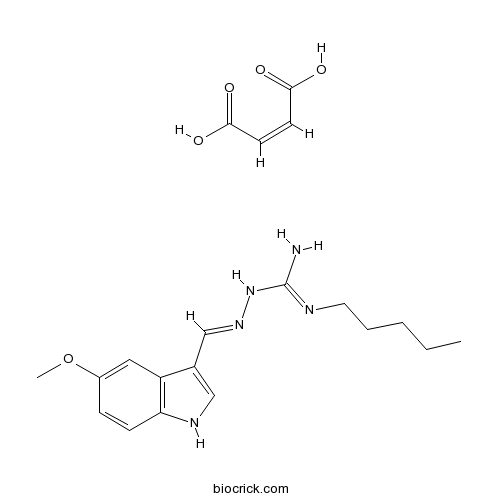
-
BCC7187
Palmitoylisopropylamide

-
BCC6836
GR 135531
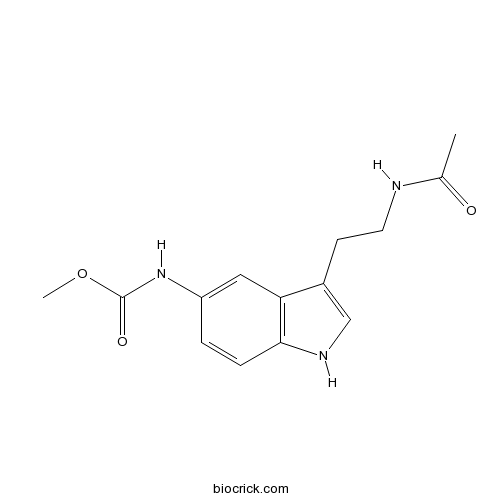
-
BCC6194
AT 1015
Long-acting 5-HT2A antagonist
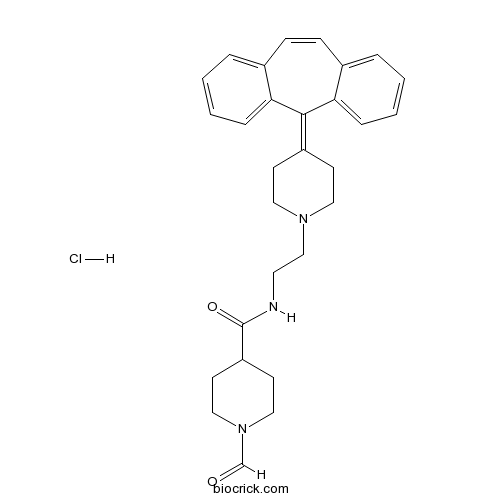
-
BCC7325
L-168,049

-
BCC7355
BIBO 3304 trifluoroacetate
BIBO3304 TFA is a potent, orally active, and selective neuropeptide Y (NPY) Y1 receptor antagonist, with subnanomolar affinity for both the human and the rat Y1 receptor (IC50=0.38 and 0.72 nM, respectively).
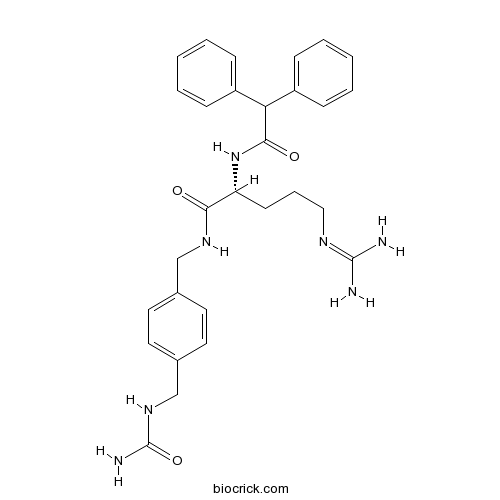
-
BCC7270
NTNCB hydrochloride

-
BCC5753
MRS 1334
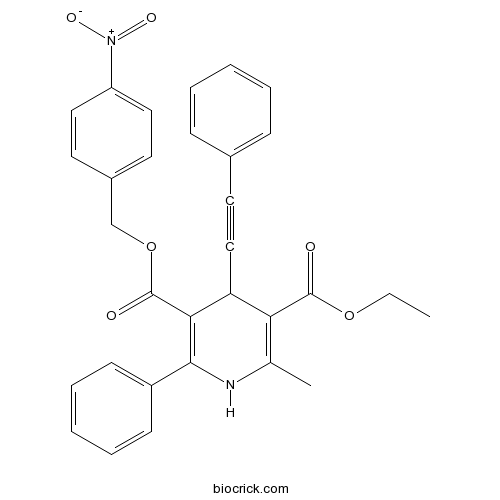
-
BCC4081
Prazosin
Prazosin is an alpha-adrenergic blocker and is a sympatholytic drug used to treat high blood pressure and anxiety, PTSD, and panic disorder.
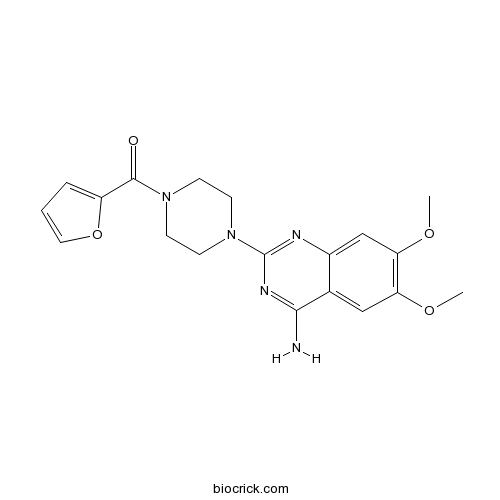
-
BCC7283
CGP 71683 hydrochloride
CGP71683 hydrochloride is a competitive neuropeptide Y5 receptor antagonist with a Ki of 1.3 nM, and shows no obvious activity at Y1 receptor (Ki, >4000 nM) and Y2 receptor (Ki, 200 nM) in cell membranes.

-
BCC2505
Prazosin HCl
Prazosin hydrochloride is an alpha-adrenergic blocker and is a sympatholytic drug used to treat high blood pressure and anxiety, PTSD, and panic disorder.





